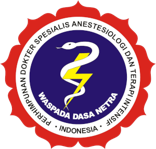Post-General Anesthesia Angioedema After General Anesthesia
Abstract
Case Illustration: A sixty-seven years old male patient 152 cm 65 kg with multiple cholecystitis and obstructive jaundice, who was scheduled to undergo laparoscopic cholecystectomy. Patient had no records of allergy to medication and food. Family has no records to hypersensitive reactions or angioedema. At initial evaluation, blood pressure was 190/90 mmHg and hemoglobin 10,4 g/dL while the rest parameter was within normal limits. We given propofol and rocuronium to induce relaxation and facilitate intubation in surgery. Approximately 90 minutes after rocuronium injection, patient evolved angioedema across the face/area, tongue, and floor of the mouth. Patient also complained of not being able to talk. Soon after that, we give 10 mg of dexamethasone and 100 mg hydrocortisone to the patient. Within 60 minutes after hydrocortisone administration the patient shows/clinical improvement that marked by swelling began to decrease and the patient was able to speak again. Then we educate patient about angioedema and its alert.
Conclusion: Anaphylaxis is a type of hypersensitivity response that take place to a particular allergen and mostly self-limited, but 11% of hypersensitive reaction require airway intervention. Most of anesthetic medication such as thiopental sodium, propofol, muscle relaxants, and etomidate may induce anaphylactic reaction during anesthesia induction. Discontinuation of underlying agent and airway control may prevent mortality and morbidity.
Keywords
Full Text:
PDFReferences
- Alhowary A, Odat H, Alali O, Al-Omari A. Intraoperative angioedema induced by angiotensin II receptor blocker: A case report. Patient Saf Surg. 2018;12(1):1-5. doi:10.1186/s13037-018-0174-0
- Tarbox JA, Bansal A, Peiris AN. Angioedema is swelling caused by fluid leakage from blood vessels into the surrounding skin and tissue. 2018;319(19):2054.
- Chiu AG, Burningham AR, Newkirk KA, Krowiak EJ, Davidson BJ, Deeb ZE. Angiotensin-converting enzyme inhibitor - Induced angioedema: A multicenter review and an algorithm for airway management. Ann Otol Rhinol Laryngol. 2001;110(9):834-840doi:10.1177/00034894011100096
- Depetri F, Tedeschi A, Cugno M. Angioedema and emergency medicine: From pathophysiology to diagnosis and treatment. Eur J Intern Med. 2019;59(September):8-13. doi:10.1016/j.ejim.2018.09.004
- Mukhdomi T, Maslow A, Joyce MF. A Case of Prolonged Angioedema After Cardiac Surgery. J Cardiothorac Vasc Anesth. 2020; 34(7):1890-1896. doi:10.1053/j.jvca.2019.12.025
- Riedl MA, Tachdjian R, Schranz J, Nurse C, Bernstein JA. Consistent Lanadelumab Treatment Effect In Patients With Hereditary Angioedema (HAE) Regardless Of Baseline Attack Frequency In The Phase 3 HELP Study. J Allergy Clin Immunol. 2018;141(2):AB47. doi:10.1016/j.jaci.2017.12.153
- Soghomonyan S, Fleming Q, Bhandary SP. Case Report: Post-operative Angioedema After a Laryngeal Mask Airway Application. Front Med. 2021;8(March):1-4. doi:10.3389/fmed.2021.566100
- Dewachter P, Kopac P, Laguna JJ, et al. Anaesthetic management of patients with pre-existing allergic conditions: a narrative review. Br J Anaesth. 2019;123(1):e65-e81. doi:10.1016/j.bja.2019.01.020
Refbacks
- There are currently no refbacks.








